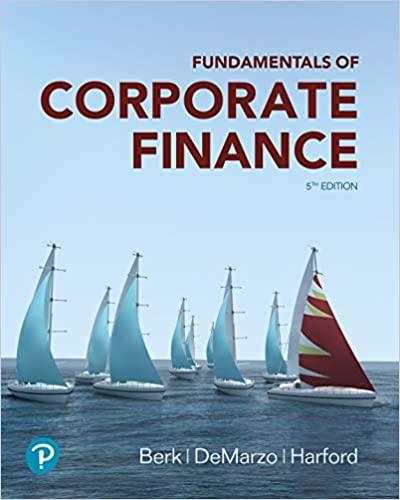Answered step by step
Verified Expert Solution
Question
1 Approved Answer
Suppose we are at the end of 2019. All cash flows arrive at the end of each year. The first cash flow arrives at the
Suppose we are at the end of 2019. All cash flows arrive at the end of each year. The first cash flow arrives at the end of 2020. Firm C will have EBIT in 2020 of $190 million. Capital expenditures will be $30 million in 2020. Depreciation will also be $30 million in 2020. The increase in net working capital, the increase in net other assets, and operating lease interest will be zero in 2020. The marginal corporate tax rate is and will be 20% in every year. Firm C's WACC at its current capital structure is and will be 7%. The expected permanent growth rate of Firm C's free cash flow and EBIT is 4% per year. Amortization will be zero in 2020 and every future year so that EBITA will equal EBIT.
Currently, Firm C is an all equity firm and has no debt. It could borrow at an interest rate of 5%. Assume that the marginal personal tax rate for equity income is and will be 30%, and the marginal personal tax rate for debt (interest) income is and will be 35%. Assume that all investors are taxable and all investments are made in taxable accounts (so there are no tax-exempt investors and no investments in tax-deferred accounts).
In a world in which the only deviation from perfect capital markets is the existence of taxes, should Firm C choose a leverage ratio (D/(D+E)) above 78% at the end of 2019 if Firm C chooses its leverage ratio to maximize its firm value? Assume that all interest payments have to be made at the end of each year and the first interest payment would have to be made at the end of 2020. Assume that any interest expense that cannot be used to reduce corporate taxes in the year it is paid cannot be used to reduce corporate taxes in any past or future year either. Ignore the limits on the tax deductibility of interest imposed by the Tax Cuts and Jobs Act of 2017.
Currently, Firm C is an all equity firm and has no debt. It could borrow at an interest rate of 5%. Assume that the marginal personal tax rate for equity income is and will be 30%, and the marginal personal tax rate for debt (interest) income is and will be 35%. Assume that all investors are taxable and all investments are made in taxable accounts (so there are no tax-exempt investors and no investments in tax-deferred accounts).
In a world in which the only deviation from perfect capital markets is the existence of taxes, should Firm C choose a leverage ratio (D/(D+E)) above 78% at the end of 2019 if Firm C chooses its leverage ratio to maximize its firm value? Assume that all interest payments have to be made at the end of each year and the first interest payment would have to be made at the end of 2020. Assume that any interest expense that cannot be used to reduce corporate taxes in the year it is paid cannot be used to reduce corporate taxes in any past or future year either. Ignore the limits on the tax deductibility of interest imposed by the Tax Cuts and Jobs Act of 2017.
Step by Step Solution
There are 3 Steps involved in it
Step: 1
To determine whether Firm C should choose a leverage ratio above 78 at the end of 2019 we need to ca...
Get Instant Access to Expert-Tailored Solutions
See step-by-step solutions with expert insights and AI powered tools for academic success
Step: 2

Step: 3

Ace Your Homework with AI
Get the answers you need in no time with our AI-driven, step-by-step assistance
Get Started


